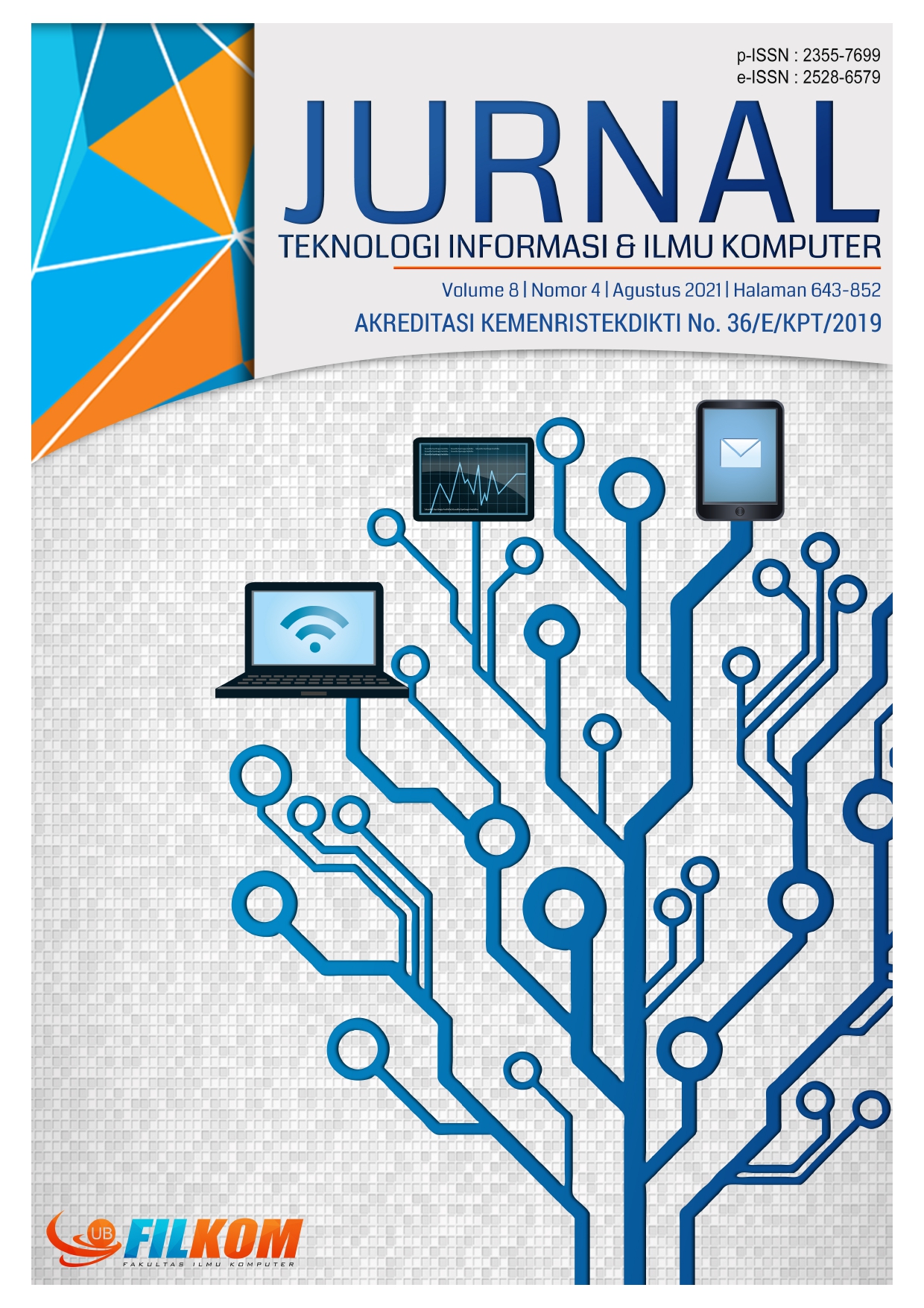Rancang Bangun Sensor Radar Sense And Avoid Uav Untuk Smart System Teletransport Alat Kesehatan
DOI:
https://doi.org/10.25126/jtiik.2021844423Abstrak
Perancangan sensor radar untuk sense and avoid (SAA) sistem pesawat tanpa awak (UAV) bertujuan agar operasi teletransport alat kesehatan dengan UAV VTOL berjalan dengan aman terhindar dari kecelakaan tabrakan di udara. Sensor radar ini didesain dengan bahan duroid 5880 dengan dielektrik konstant 2.2 dan ketebalan subtrate 1.57 mm. Bentuk antenna circular dan bekerja di pita ku-band 14 Ghz. Terdapat dua sensor untuk Tx dan Rx dalam satu substrate. Hasil simulasi sensor menunjukkan bandwitdh yang lebar 1.5 GHz sehingga mampu menghasilkan resolusi range sangat baik yaitu 9.2 cm. Penguatan antenna dihasilkan 7.32 dB dan sudut beamwidth sensor 83O arah azimuth dan 78.2O arah elevasi. Sensor ini akan disematkan pada sistem SAA dengan algoritma neural network yang mendrive manuever UAV VTOL berbelok kesamping pada sudut dan jarak yang tepat sehingga terhindar dari tabrakan dengan objek penghalang.
Abstract
The design of the radar sensor for the sense and avoid (SAA) system of unmanned aircraft (UAV) aims to make teletransport operations of medical devices with UAV VTOL run safely avoiding collisions in the air. This radar sensor is designed with duroid 5880 material with a dielectric constant of 2.2 and a subtrate thickness of 1.57 mm. The antenna is circular and works on the 14 Ghz ku-band band. There are two sensors for Tx and Rx in one substrate. The sensor simulation results show a wide bandwidth of 1.5 GHz so that it is able to produce a very good range resolution of 9.2 cm. The antenna gain was 7.32 dB and the beamwidth angle of the sensor was 83O in the azimuth direction and 78.2O in the elevation direction. This sensor will be embedded in the SAA system with a neural network algorithm that drives the UAV VTOL maneuver to turn sideways at the right angle and distance so that it avoids collisions with obstructions.
Downloads
Referensi
ANGGRAENI, S., dkk, 2020. The Deployment of Drones in Sending Drugs and Patient Blood Samples COVID-19. Indonesian Journal of Science & Technology, 5(2), pp.193–200.
BALLANIS, C.A., 2016. Antenna Theory, Analysis and Design. John Wiley and Son, New York.
FORLENZA, I.L., n.d. Vision based strategies for implementing Sense and Avoid capabilities onboard Unmanned Aerial Systems. UNIVERSITÀ DEGLI STUDI DI NAPOLI “FEDERICO II”.
GARCIA-FERNANDEZ, M., dkk., 2018. UAV-mounted GPR for NDT applications. 2018 15th European Radar Conference, EuRAD 2018, pp.2–5.
MOORE, E., 2019. Radar Detection, Tracking and Identification for UAV Sense and Avoid Applications. Electronic Theses and Dissertations. [online] Available at: <https://digitalcommons.du.edu/etd/1544>.
PHAM, H., dkk, 2015. A survey on unmanned aerial vehicle collision avoidance systems. [online] (1). Available at: <http://arxiv.org/abs/1508.07723>.
SOKAČ, M., dkk, S., 2016. UAV application in ecology: Data collecting with quad-copter equipped with Arduino based measurement platform. Proceedings Elmar - International Symposium Electronics in Marine, 2016-Novem(September), pp.233–236.
TETUKO, J., dkk., 2017. Development of circularly polarized synthetic aperture radar on-board UAV JX-1. International Journal of Remote Sensing, [online] 38(8–10), pp.2745–2756. Available at: <http://dx.doi.org/10.1080/01431161.2016.1275057>.
VENKATA SUBBA RAO, P. & GORANTLA, S.R., 2019. Design and Modelling of anAffordable UAV Based Pesticide Sprayer in Agriculture Applications. 5th International Conference on Electrical Energy Systems, ICEES 2019, 360(February), pp.1–4.Ballanis, C.A. (2016) Antenna Theory, Analysis and Design. John Wiley and Son, New York.
ZHAHIR, A., RAZALI, A. & MOHD AJIR, M.R., 2016. Current development of UAV sense and avoid system. IOP Conference Series: Materials Science and Engineering, 152(1).
Unduhan
Diterbitkan
Terbitan
Bagian
Lisensi

Artikel ini berlisensi Creative Common Attribution-ShareAlike 4.0 International (CC BY-SA 4.0)
Penulis yang menerbitkan di jurnal ini menyetujui ketentuan berikut:
- Penulis menyimpan hak cipta dan memberikan jurnal hak penerbitan pertama naskah secara simultan dengan lisensi di bawah Creative Common Attribution-ShareAlike 4.0 International (CC BY-SA 4.0) yang mengizinkan orang lain untuk berbagi pekerjaan dengan sebuah pernyataan kepenulisan pekerjaan dan penerbitan awal di jurnal ini.
- Penulis bisa memasukkan ke dalam penyusunan kontraktual tambahan terpisah untuk distribusi non ekslusif versi kaya terbitan jurnal (contoh: mempostingnya ke repositori institusional atau menerbitkannya dalam sebuah buku), dengan pengakuan penerbitan awalnya di jurnal ini.
- Penulis diizinkan dan didorong untuk mem-posting karya mereka online (contoh: di repositori institusional atau di website mereka) sebelum dan selama proses penyerahan, karena dapat mengarahkan ke pertukaran produktif, seperti halnya sitiran yang lebih awal dan lebih hebat dari karya yang diterbitkan. (Lihat Efek Akses Terbuka).












